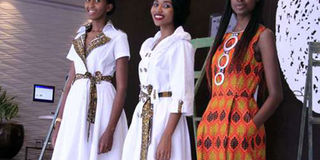Analysing the state of local fashion industry

Models showcase designs by local fashion houses at the Radisson Blu Hotel on June 21, 2016. PHOTO | DIANA NGILA
What you need to know:
- New report offers a candid, unfiltered reality check. The fashion and textile industry’s ugliness comes fully unhinged.
- Think before you take that money and run. Think of children’s clothing for example. Or underwear designed for African proportions, both male and female. How about sustainable, ethical fashion instead of fast fashion, the former about buying and keeping what you love and value and the latter, instant gratification?
How do you eat a fashion elephant? The answer lies inside 100 pages of a new report titled The Kenyan Textile and Fashion Industry: The Role of Fashion Designers and Small Tailors in the Fibre to Fashion Value Chain.
Hivos, Equity Bank and the Association of Fashion Designers of Kenya (AFAD) commissioned the study which compares the domestic market against the global landscape.
It does not look pretty. Many challenges spiral the industry in a near chokehold. Instead of charging the field with hoes, we are posturing. But to its credit, the industry is resilient.
The report does not make for an easy read. Not because it is generous with statistics, which is it, but because it offers a candid, unfiltered reality check. The fashion and textile industry’s ugliness comes fully unhinged. Territorial and fragmented at best, it is most certainly not living up to its promise. During the launch of the report on June 21, conversation highlighted, rather aptly, a situation the report labels as “bipolar.”
The advantage of being Kenyan now is this - we have access to all the mistakes others have made. For instance. Fashion is 80 per cent female oriented with the potential to employ 300,000. However, it employs a little over 40,000.
But these are mainly wage earners. In a world debating the absence of women leaders, fashion is no exception. Kenyan fashion grapples with a notable laxity in thought leadership, strategy and direction. What we ought to be doing is getting ahead of this. Needed: more women heading, running, founding and managing vibrant, dynamic fashion, communication, strategy and lifestyle brands, compelling businesses that transform long term. Women as more than fashions’ handmaidens.
PASSIONATE GOVERNMENT
Each of the findings in this report begs investigation though it says much that has been said before and then some. Did you know at it’s peak Kenya had almost a quarter of a million farmers and textile households, 70 textile mills and 20 ginneries? In the 1980s the fashion and textile industry accounted for 30 per cent of all manufacturing employment.
It took more than mitumba to bring that down. Our industry appears simple yet it needs a flowchart to break down its complexity. It makes money too. Ninety-five per cent of Made in Kenya products from the Export Processing Zones were sold to the US for $400 million in 2014, one per cent in Canada and 1.5pc in the East African Community.
The government speaks passionately and in great detail about what it has done for us lately. Except they can’t want success for the industry more than the industry wants for itself. Government needs pushback, interaction and direction. It is remarkable how little pressure the industry is applying. This is because players are isolated in their struggle. That struggle, my dear people, is not real. Government cannot drag you kicking and screaming into the land of milk and honey.
It is near impossible to streamline our industry because fashion and textile are siloed. Without links and relationships there cannot be progress. Again, most fashion talent is self-employed. This is great. Except 60pc are operating from their homes as unregistered entities and over 80pc are not certified by the Kenya Bureau of Standards. The biggest challenge for businesses is entrepreneurship skills. If a sewing machine runs in the forest, and the government does not hear its buzz, does it still exist?
What the report does not say but I will is that the industry is not challenging itself enough. There are as many ways to be innovative as there are active minds. They do not have to revolve around fame, a one-dimensional definition of creativity or money. Technology is our friend. So is constant learning and upgrading of skills.
Ethiopia and Mauritius are kicking our butts because they refined their perspectives. Kenya needs talent powered by vision, individual and collective. This must happen before inviting venture capitalists, angel investors and in the case of this report, how a government sit-down with banks will lead to access to capital.
Think before you take that money and run. Think of children’s clothing for example. Or underwear designed for African proportions, both male and female. How about sustainable, ethical fashion instead of fast fashion, the former about buying and keeping what you love and value and the latter, instant gratification?
See possibilities in the luxury market. Before we jump tourists, has the domestic market with its cosmopolitan, Westernised bent been attended to? So many questions in this report. I wonder if we have the courage to confront them in order to find answers.





